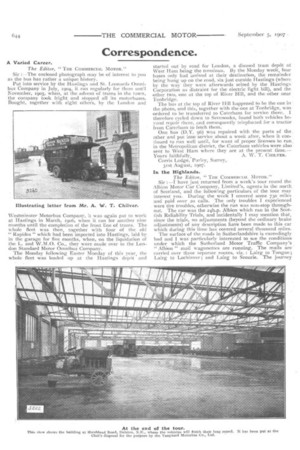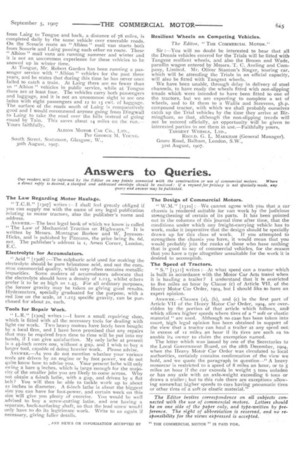Correspondence.
Page 24

Page 25

If you've noticed an error in this article please click here to report it so we can fix it.
A Varied Career.
The Editor, " THE COMMERCIAL. MOTOR."
Sir :—The enclosed photograph may be of interest to you as the bus has rather a unique history. Put into service by the Hastings and St. Leonards Omnibus Company in July, 1904, it ran regularly for them until November, 1903, when, at the advent of trams in the town, the company took fright and stopped all its motorbuses. Bought, together with eight others, by the London and Westminster Motorbus Company, it was again put to work at Hastings in March, 1906, when it ran for another nine months until the completion of the front line of trams. The whole fleet was then, together with four of the old " Rapides " which had been imported into Hastings, laid by in the garage for five months, when, on the liquidation of the L. and W.M.O. Co., they were made over to the London Standard Motor Omnibus Company. The Monday following Easter Monday of this year, the whole fleet was loaded up at the Hastings depfit and started out by road for London, a disused tram depot at West Ham being the terminus. By the Monday week, four buses only had arrived at their destination, the remainder being hung up on the road, six just outside Hastings (where by the way they were afterwards seized by the Hastings Corporation as distraint for the electric light bill), and the other two, one at the top of River Hill, and the other near Tonbridge.
The bus at the top of River Hill happened to be the one in the photo, and this, together with the one at Tonbridge, was ordered to be transferred to Caterham for service there. I therefore cycled down to Sevenoaks, found both vehicles beyond repair there, and consequently telephoned for a tractor from Caterham to fetch them.
One bus (D.Y. 96) was repaired with the parts of the . other and put into service about a week after, when it continued to run well until, for want of proper licenses to run: in the Metropolitan district, the Caterham vehicles were also sent to West Ham where they are at the present time.— Yours faithfully, A. W. T. CHILVER. COrris Lodge, Purley, Surrey, 31st August, 1907.
In the Highlands.
The Editor, " THE COMMKRCIAI. MOTOR."
Sir have just returned from a week's tour round the Albion Motor Car Company, Limited's, agents in the north of Scotland, and the following particulars of the tour may interest you. During the week I covered some 730 miles and paid over 20 calls. The only troubles I experienced were tire troubles, otherwise the run was non-stop throughout. The car Was the 24h.p. Albion which ran in the Scottish Reliability Trials, and incidentally I may mention that, since the trials, no adjustments (beyond the ordinary brake adjustments) of any description have been made to this car which during this time has covered several thousand miles. The surface of the roads in Sutherlandshire is exceedingly bad and I was particularly interested to see the conditions. under which the Sutherland Motor Traffic Company's " Albion " mail wagonettes are running. The mails arecarried over three separate routes, viz. : Lairgto Tongue; Lairgto Lochinver ; and Lairg to Scourie. The journey
from Lairg to Tongue and back, a distance of 78 miles, is completed daily by the same vehicle over execrable roads. On the Scourie route an " Albion " mail van starts both from Scourie and Lairg passing each other en route. These " Albion " mail vans are running summer and winter and it is not an uncommon experience for these vehicles to be snowed up in winter time.
At Tongue, Mr. Robert Garden has been running a passenger service with " Albion " vehicles for the past three years, and he states that during this time he has never once failed to catch a train. At Lairg there are no fewer than to " Albion " vehicles in public service, while at Tongue there are at least four. The vehicles carry both passengers and luggage, and it is not an uncommon sight to see one laden with eight passengers and 12 to 15 cwt. of luggage. The surface of the roads south of Lairg is comparatively good and I would recommend anyone going from Dingwall to Lairg to take the road over the hills instead of going round by Tain. This saves about 14 miles on the run.— Yours faithfully,
ALBION MOTOR CAR Co., LTD., Per GEORGE M. YOUNG. South Street, Scotstoun, Glasgow, W., 3oth August, 1907. Resilient Wheels on Competing Vehicles.
The Editor, "Ti-is COMMERCIAL MOTOR."
Sir :—You will no doubt be interested to hear that all the Dennis vehicles entered for the Trials will be fitted with Tangent resilient wheels, and also the Broom and Wade, paraffin wagon entered by Messrs.-T. C. Aveling and Company, Limited. Mr. Oliver Stanton's Singer, touring car, which will be attending the Trials in an official capacity, will also be fitted with Tangent wheels.
We have been unable, through delay in delivery of steel channels, to have ready the wheels fitted with non-slipping treads which were intended to have been fitted to one of the tractors, but we are expecting to complete a set of wheels, and to fit them to a Wallis and Steevens, h.p. compound tractor, with which we shall probably ourselves catch up the Trial vehicles by the time they arrive at Birmingham, so that, although the non-slipping tre2ds will not be entered officially, an opportunity will be given to interested parties to see them in use.—Faithfully yours, TANGENT WHEELS, LTD., REGLD. G. L. MARKHAM (General Manager). Grove Road, Balham, London, S.W., 31st August, 1907.
































